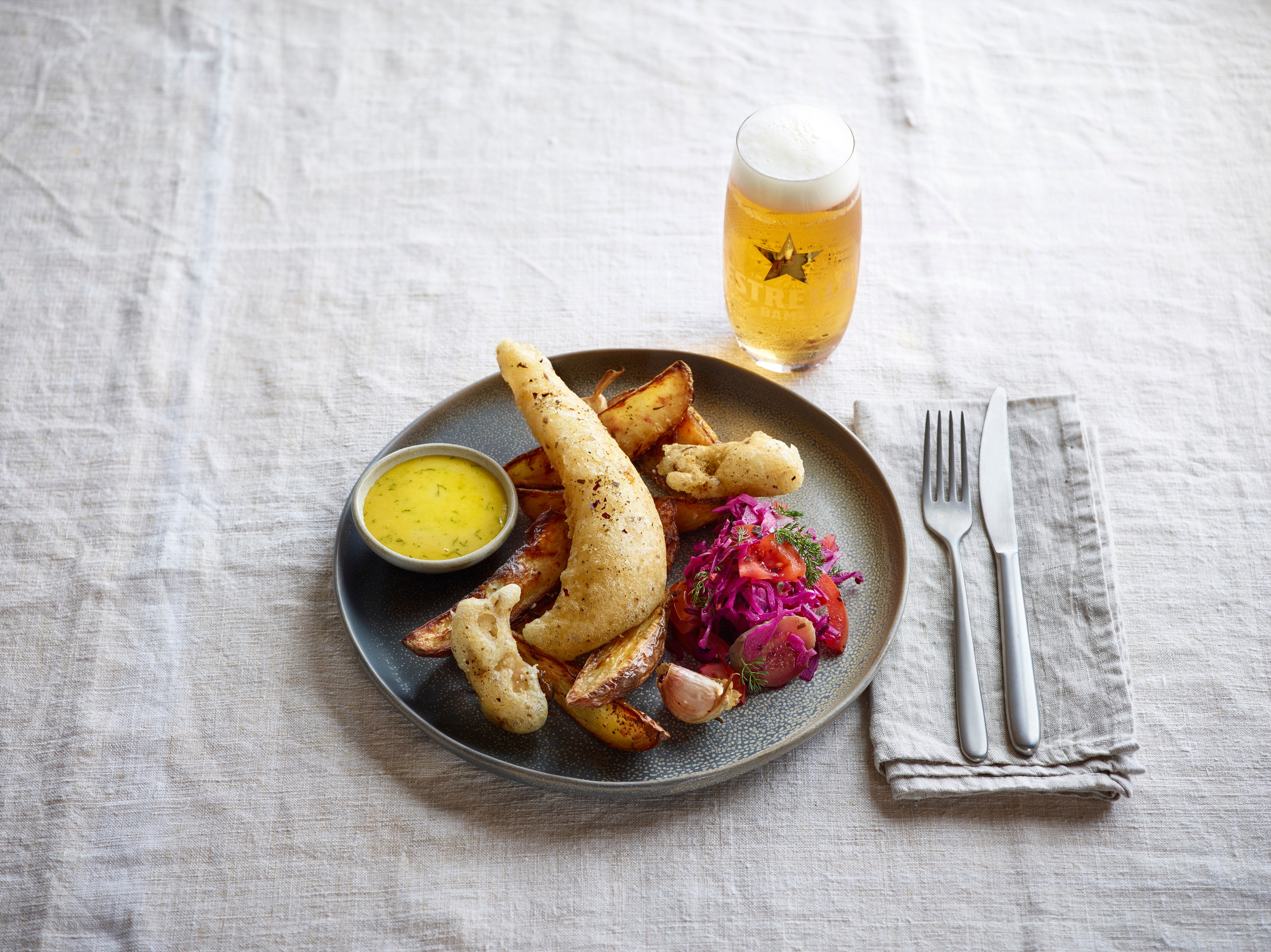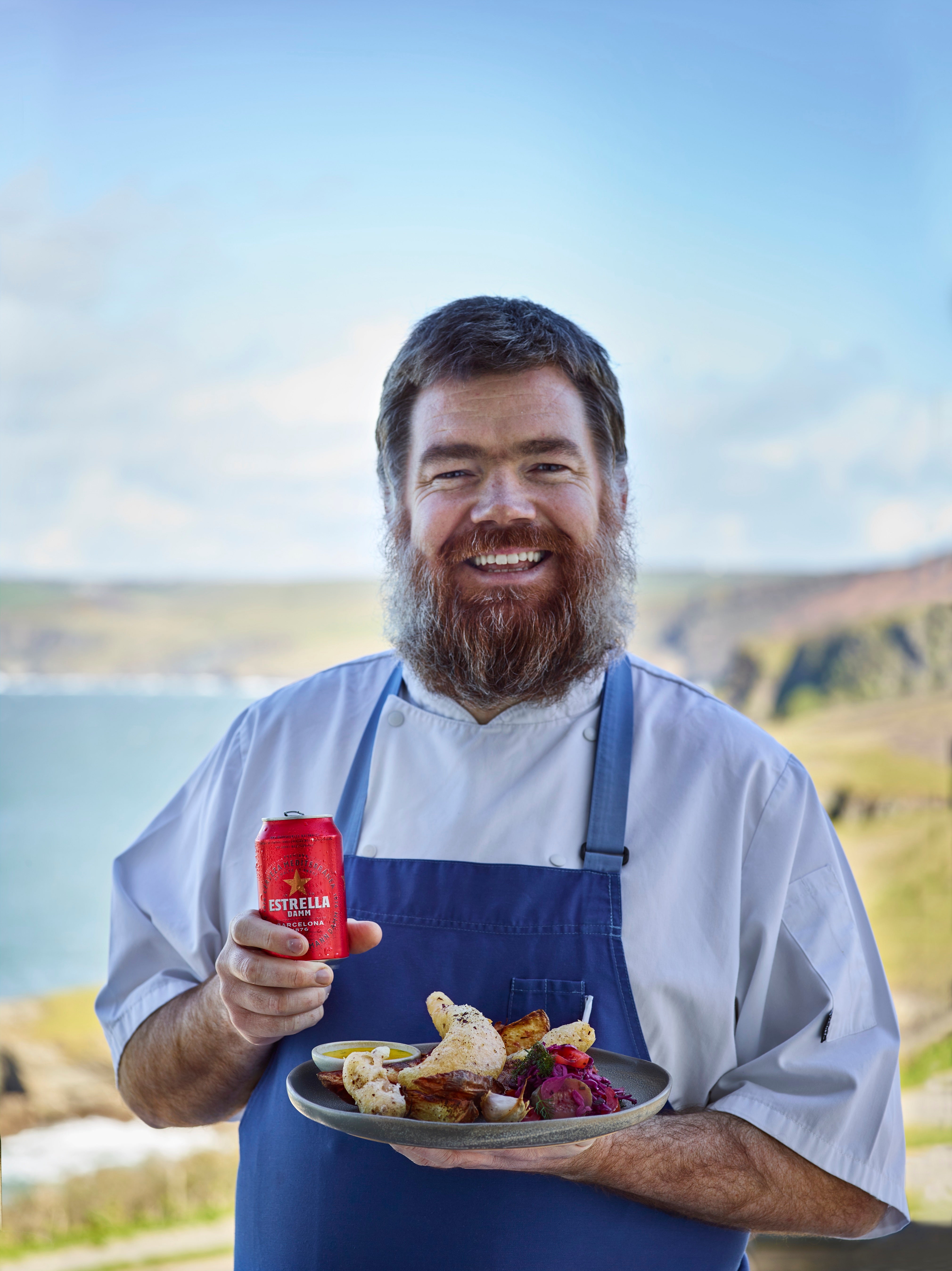What is the future of fish and chips if we don’t protect oceans?
Fish suppers could look very different if action isn’t taken, finds Ella Walker

Golden batter that rustles in vinegar-drenched paper, shards of crisp potato, a polystyrene tub of mushy peas, a wedge of lemon and a slice of heavily buttered bread if you’re very lucky – fish and chips is an institution of seaside and Friday night deliciousness. But will it always be this glorious way?
Perhaps not. The plight of our oceans and marine life is well documented, from climate change and overfishing to plastic pollution – eight million tons of plastic end up in oceans every year; animals are killed by it; and the fish we eat contains microplastics.
The stats definitely make the thought of cod and chips a little less appetising. But what if we used that environmental anxiety and concern to raise awareness and drive change? That’s what Estrella Damm and Michelin-starred chef and seafood aficionado Nathan Outlaw are hoping to do. Outlaw’s created a dish that imagines the cod-free fish suppers of the future we might be destined for, if we fail to tackle ocean plastic pollution.
It could all sound a little worthy – particularly when they aren’t advocating major plant-based diet overhauls, or lobbying governments for change – but it’s an intriguing concept. I decide to put Outlaw’s part-recipe, part-sustainability-reminder to the test.
Read more:
The menu reads elegantly: a white slab of battered Cornish sole (more sustainable than cod, but not a guaranteed future food source either), deep-fried sustainably farmed oysters, pickled red cabbage with tomatoes, roast garlic chips (OK, wedges), and handmade curry sauce mayo – all with a decent smattering of seaweed flakes.
In the spirit of frankness, please only attempt this when there’s time to faff with oysters (all too intent on staying in their shells) and to tidy up the kitchen post-frying with beef fat (tallow might be a useful by-product, but it is messy). That said, deep-frying the oysters is incredibly satisfying – they bob resplendent in the molten fat and come out plump and crunchy – while the sole is substantial, soft and sweet. Normal mayo (from a jar, ahem) would have done the trick, but the pickles are crucial – they cut through all that batter and the rich chips.
Effort is very much required – but that’s likely part of the point. Cooking this dish will make you really think about and value the fish on your plate, and where it’s come from – as well as your fondness for the local chippie.
How to make Nathan Outlaw’s battered Cornish sole and oysters
Serves 2
Ingredients
1 Cornish Sole, filleted and skinned
6 oysters
200ml ice cold sparkling water
200g gluten free self-raising flour, plus extra for dusting
Tallow or beef dripping for deep frying
Cornish seaweed flakes for seasoning
Salt and black pepper
For the red cabbage pickles:
¼ of a normal sized red cabbage, outer leaves removed, thinly sliced
1 red onion, peeled and thinly sliced
2 ripe tomatoes
1tbsp dried seaweed flakes
100ml cider vinegar
100ml apple juice
100ml water
75g sugar
Extra seaweed flakes for seasoning
For the curry sauce mayonnaise:
2 free range egg yolks
1tsp English mustard
2tsp cider vinegar
250ml cold pressed rapeseed oil
2tbsp chopped coriander
1tsp mild curry powder
For the roast garlic chips:
4 large Maris Piper potatoes, washed with skin on
1 bulb of garlic, broken into cloves with the skin left on
2 sprigs of rosemary
Seaweed flakes to sprinkle
Tallow or beef dripping, for cooking
Method

1. For the pickles, bring all the liquids to the boil with the sugar. Simmer for five minutes and then add a pinch of salt. Place the red cabbage, seaweed and red onion into a bowl and mix together. Pour over the boiling pickling liquid and make sure the ingredients are submerged (a weight is useful) leave the red cabbage to cool and pickle for at least two hours, but preferably in the fridge overnight. To serve, drain the liquid off and mix with the sliced tomatoes. Season with salt, pepper, and more seaweed flakes. Mix well and leave to come up to room temperature before serving.
2. For the curry sauce, placed the egg yolks, vinegar, curry powder and mustard together in a large food processor and blend until well combined. Slowly add the rapeseed oil in a steady stream while continuing to blend until emulsified. Add the chopped coriander and blend for 30 seconds, scrape down the sides of the food processor bowl and blend for another 30 seconds. Taste and adjust the seasoning with sea salt and pepper, as necessary. Store in the fridge until ready to serve.
3. Cut the potatoes into large chips. Put them into a saucepan, cover with cold water, season the water with salt and bring to the simmer. Cook for 10 minutes until still slightly raw in the centre, strain and cool on a tray.
4. Place a sieve over a bowl and shuck the oysters, flipping them into the sieve to drain off any oyster juice. If not using straight away leave the oysters in the sieve in the fridge with the bowl underneath.
5. Heat some tallow or beef dripping in a deep-fat fryer or large pan to 180˚C.
6. For the batter, put the flour into a large bowl then whisk in the ice-cold sparkling water to combine thoroughly so that the mixture is smooth and lump free. Move to a cool place until ready for frying.
7. Preheat your oven to 200˚C. Place two tablespoons of tallow or beef dripping into a roasting tin with the garlic cloves and place the tin into the oven. Cook for 10 minutes. Next add the potatoes to the tray and season with salt and pepper. Cook the potatoes for 30 minutes until golden brown, turning every 10 minutes for even cooking. When the potatoes are almost there add the rosemary and start the fish cooking.
8. To cook the fish and oysters, first mix the batter again to ensure it is smooth. Pass each fillet of fish and oyster through some flour and pat off any excess. Using tongs or tweezers place the fish and oysters, one by one through the mixture to evenly coat then drop carefully into the fryer. Cook for two to three minutes until golden brown. (Note: Always drop items into the fryer away from your body so the oil does not splash back!) Carefully remove the fish and oysters once cooked and drain onto kitchen paper. Season with sea salt and seaweed flakes.
9. To serve, place the fish and oysters together to bulk this out, add them on top of the chips and cover with the red cabbage pickles and a healthy dollop of curry sauce mayonnaise.
The partnership between Outlaw and Estrella Damm is part of ‘Lovers’, the second film in its sustainability-focused campaign. For more information, click here.
Join our commenting forum
Join thought-provoking conversations, follow other Independent readers and see their replies
Comments